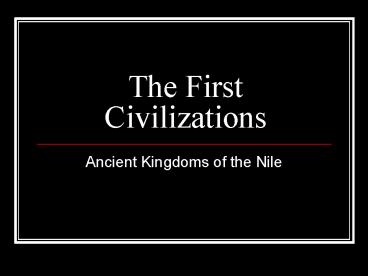The First Civilizations - PowerPoint PPT Presentation
1 / 10
Title:
The First Civilizations
Description:
Origins of the Nile Valley Civilization. A number of ancient cultures ... 12,000 years ago covered by swampland Hippos and Crocodiles. The Nile River ... – PowerPoint PPT presentation
Number of Views:30
Avg rating:3.0/5.0
Title: The First Civilizations
1
The First Civilizations
- Ancient Kingdoms of the Nile
2
Terms
- Oasis
- Silt
- Hieroglyphics
- Papyrus
- Kingdom
- Monarchy
- Pharoah
- Dynasty
- Empire
- Polytheism
- Monotheism
3
Origins of the Nile Valley Civilization
- A number of ancient cultures influenced its
development - Early hunter-gatherers circa 12,000 b.c.
- Formed settlements and turned to farming
- Plants cultivated in Nile Valley grew elsewhere
- Civilizations to the North may have influenced
its development
4
Physical Setting of Egypt
- 12,000 years ago covered by swampland Hippos
and Crocodiles - The Nile River
- Longest river in the world 4,160 miles
- Main sources
- White Nile begins near lake Victoria in Eastern
Africa - Blue Nile begins at Lake Tana in Ethiopian
Highlands - 6 cataracts (areas of rapids)
- Nile Valley people built civilizations in the 750
mile stretch between the Mediterranean Sea and
the first cataract
5
The Gift of the Nile
- Herodotus ancient greek historian, wrote of his
travels in Northern Egypt. - Annual flood flatland of Nile Valley
- June to October
- Rain fell on Ethiopian Plateau near source of
Nile - Left layer of silt (fertile soil)
- Farmers planned work around the flood
- Little rain falls directly o Egypt
- Early on Farmers learned to use Nile River waters
for Irrigation - Dug short canals to carry water to fields
- Possible to grow 2-3 crops per year
6
Other Natural Resources of the Nile Valley
- Sunny, frost-free climate
- Prevailing winds
- Travel and trade
- Unite the region
- Deposits of granite, limestone and sandstone -
used minerals for building - Location
- Deserts and seas provided natural barrier against
invaders - Isthmus of Suez
- Land bridge between Africa and Asia
- Trade route
- Exchange of ideas
7
Early Steps Toward Civilization
- Neolithic culture developed around 6000 b.c.
- 3800 b.c.
- mined copper
- discovered how to make bronze
- glazed pottery
- Began to use Hieroglyphics
8
Hieroglyphics
- Hieros sacred
- Gluphein to carve
- More than 600 hieroglyphic signs, pictures, or
symbols to indicate words or sounds - Carved in stone and other hard materials
- Discovered paper
- Papyrus plant
- Cut stems of plant into long, thin slices
- Moistened strips, arranged them in layers,
ressed them into a mat - Wrote on papyrus with ink from soot, water and
vegetable gum - Sharp reed used as a pen
- 1798 a.d. discovery of the Rosetta Stone during
Napoleans invasion of Egypt - Jean Francois Champollion deciphered the
hieroglyphic symbols 23 years after the discovery
of the Rosetta Stone
9
Hieroglyphics
- The written Egyptian language, hieroglyphics, is
made up of three types of symbols. - Alphabetic signs correspond to a letter or sound
produced by that sign. - Syllabic symbols stand for sounds produced by a
group of letters, a syllable. - Determinative signs relate to a specific object
or idea, such as man, woman, and water. - Hieroglyphics can be read from left to right,
right to left, or top to bottom. The direction
depends on the direction the symbols are facing.
10
(No Transcript)































